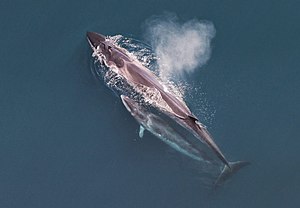Seiwal
| Seiwal | ||||||||||||
|---|---|---|---|---|---|---|---|---|---|---|---|---|

Sei whale ( Balaenoptera borealis ) |
||||||||||||
| Systematics | ||||||||||||
|
||||||||||||
| Scientific name | ||||||||||||
| Balaenoptera borealis | ||||||||||||
| Lesson , 1828 |
The Sei Whale ( Balaenoptera borealis ) is a species of whale from the family of the furrow whales (Balaenopteridae). The name "Sei" comes from the Norwegian word for pollock and comes from the fact that some of the animals feed on these fish and can be found in the vicinity of schools.
distribution
Sei whales occur in all oceans worldwide between 60 ° north and 60 ° south latitude. In summer they stay in temperate or sub-polar regions, in order to migrate to subtropical seas in winter. According to the distribution area, two subspecies are distinguished, the northern sei whale ( B. b. Borealis ) and the southern sei whale ( B. b. Schleglii ).
description
Sei among the baleen whales (Mysticeti) obtained by 600-680 Barten are presented instead of the teeth in the mouth. They reach an average length of 12 to 16 meters and a weight of around 20 to 30 tons, the largest animals are up to 20 meters long and 45 tons heavy. They are characterized by a slim, elongated body that is dark gray on the top and whitish on the underside. They have a pointed snout, a sickle-shaped fin and a small fluke compared to the rest of the body . A skeleton with organs is exhibited in the Stuttgart Natural History Museum.
Way of life
Sei whales usually live in pairs or small groups in the open sea; larger schools can be found in rich feeding grounds. They are the fastest swimmers among the furrow whales and can reach up to 25 knots (around 45 km / h). Your dives are short (five to ten minutes) and not very deep.
food
The diet of the sei whales consists of krill and schooling fish up to 30 centimeters in size , including the eponymous pollock. They often swim on their side while eating.
Reproduction
Mating takes place in the winter months (in the northern hemisphere from November to February, in the southern hemisphere from May to July), and the gestation period is around 10.5 to 12 months. Sei whale calves are around four to five meters long and weigh 600 to 750 kilograms when they are born. The young animals are weaned after six to seven months. Although they reach sexual maturity around ten years of age, it takes up to 25 years for them to mature. Their life expectancy is estimated at up to 75 years.
Whaling and Threat
Although sei whales inhabit the same areas as blue , fin and humpback whales , they were not traditional prey for whalers . It was only when the populations of the other species declined that the sei whale came into the sights of the whalers. In the 20th century, more than 200,000 animals of this species were shot, particularly in the southern hemisphere. The species has been protected since 1976, but since then Icelanders , Japanese and Norwegians have hunted a small number for alleged research purposes. The scientific value of these hunts is questionable, as no research results are published, but the catches are used commercially. Today one assumes around 50,000 to 60,000 living specimens of the sei whale, the IUCN lists it as threatened.
Since April 2015, more than 300 dead sei whales have washed up off Patagonia in Chile , although the actual number is likely to be higher due to the inaccessibility of the area. According to a scientific study, a toxic algal bloom , triggered by the El Niño climatic phenomenon , led to the death of the animals. The scientists see the increasing number of mass deaths caused by poisonous algal blooms as a threat to the conservation of threatened whale species.
literature
- Mark Carwardine : Whales and Dolphins . Delius Klasing, 2008, ISBN 978-3-7688-2473-6 (high quality guide)
- Ralf Kiefner: whales and dolphins worldwide. Pacific Ocean, Indian Ocean, Red Sea, Atlantic Ocean, Caribbean, Arctic, Antarctica. Jahr-Top-Special-Verlag, Hamburg 2002, ISBN 3-86132-620-5 (guide of the magazine "tauchen", very detailed).
- J. Niethammer, F. Krapp (ed.): Handbook of mammals in Europe. Volume 6: marine mammals, Tel 1A: whales and dolphins 1 . AULA-Verlag, Wiesbaden 1994 (very detailed textbook)
- RR Reeves, BS Stewart, PJ Clapham, JA Powell: Sea Mammals of the World - a Complete Guide to Whales, Dolphins, Seals, Sea Lions and Sea Cows . A&C Black, 2002, ISBN 0-7136-6334-0 (guide with numerous pictures)
- Maurizio Würtz, Nadia Repetto: Dolphins and Whales. White Star Guides et al., Vercelli et al. 2003, ISBN 88-8095-943-3 (identification book).
Web links
- Balaenoptera borealis in the endangered Red List species the IUCN 2006. Posted by: Cetacean Specialist Group, 1996. Retrieved on 11 May, 2006.
Individual evidence
- ^ Whale mass extinction off Chile
- ↑ Günter Försterra, Fanny E. Horwitz, Kaitlin M. McConnell, Hector H. Sepúlveda, Maria Jose Perez-Alvarez: Largest baleen whale mass mortality during strong El Niño event is likely related to harmful toxic algal bloom . In: PeerJ . tape 5 , May 31, 2017, ISSN 2167-8359 , p. e3123 , doi : 10.7717 / peerj.3123 ( peerj.com [accessed July 1, 2019]).


